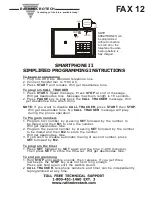
GAI-TRONICS
VoIP Telephone Configuration Guide
Page 75 of 78
•
Snmp community 2
•
Snmp community 2 access
•
Snmp trap enable -> enabled (this parameter is disabled by default)
•
Snmp trap server (to be the IP address of the remote server receiving SNMP traps)
•
Snmp trap community
9.2
Maintenance
Maintainence requires the use of the correct MIB file. Make sure the correct version of MIB is
used
– the MIB will usually be related to a specific version of firmware. MIB files are
published on our website together with which version(s) of firmware they are applicable to.
The MIB tree follows the web page structure as described in section 4, and the parameter
names are the same as those used on the web pages.
Any parameter that can be viewed on the web pages can be read using a GET commend in
SNMP..Any parameter that can be edited on the web pages can be set using a SET
command in SNMP.
Note
– any changes made need to be saved using the systemConfigAndSave
parameter in the systemSave section of the MIB tree, otherwise the changes will be
lost.
9.3
SNMP Traps
SNMP traps are sent for faults and events generated by the telephone.
Fault traps are the same as those listed in section 10, ie
Fault description
Trap code
fault_sip_provider0_reg_failed
1
fault_sip_provider1_reg_failed
2
fault_sip_provider2_reg_failed
3
fault_sip_provider3_reg_failed
4
fault_loop_detected
8
fault_off_hook_idle_timeout
10
fault_configuration_error
11
fault_keyboard_error
13
fault_audio_path_test_failure
14
fault_power_interruption
16
fault_fault_log_full
17
In addition, the following event traps are sent:
Event description
Trap code
Audio path test pass
15
Input1 On
21
Input1 Off
22
Input2 On
23
Input2 Off
24
Input3 On
25
Input3 Off
26
Input4 On
27
Input4 Off
28
On Hook
29
Off Hook
30
Traps are UDP, sent via port 162.
10.
Fault reporting (via SNMP and / or FTP)
The telephone can self-diagnose various faults and report them using a number of methods:
•
Web page
•
Fault log (sent via FTP
– see below)
•
SNMP (see section 9), or




































